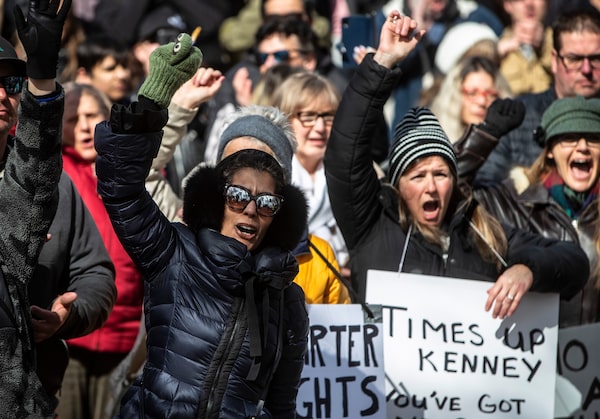
Anti-lockdown and anti-mask protesters take part in a rally outside the Alberta Legislature in Edmonton on April 12, 2021.JASON FRANSON/The Canadian Press
Follow the Leader was a game most of us played as kids. Someone (usually self-appointed) was the leader and the rest of the team followed them, whether it was running around the playground, climbing through bushes or tumbling in the play structure. It was fun, particularly if the leader took us places that challenged or intrigued us. And, if we didn’t like the game, instead of blaming the leader we could simply choose to stop playing.
Leadership today shares many of the same elements: not always sure where we are going, uncertain what the terrain will be, or what the next step might entail. But unlike the game at the playground, we are in the middle of a public health crisis, and following the leader is important to get us through this.
Here in Alberta, we recently had a notable example of a provincial leader whose decisions on reimposing restrictions met with public backlash from a significant percentage of caucus members – each of whom is also expected to be a leader in their ridings and for the government as a whole. While those who oppose restrictions may have applauded, I think most people cringed at the act of rebellion and expected the Premier to crack down on the dissenters.
Instead, the Premier publicly acknowledged that there are inevitable differences of opinion in a democracy, and even encouraged more debate. Whether that was the right move only time will tell at a future election. In my view, it was not the right leadership approach, even allowing for the particulars of the political realm. Inviting disagreement from other leaders in the team – especially in a visible form – does nothing to instill public confidence. And, right now, confidence in government actions is paramount. With it will come a higher level of trust, and with that will come compliance (one hopes).
Alberta is far from unique in terms of public push back on COVID-19 restrictions. Over the past weeks we have many examples of rule breaking, including gatherings in private homes, looting in streets after curfew and refusals to wear masks. Even stories about skipping mandatory quarantines are coming out more frequently.
This is troubling in itself, but it’s compounded when the core leadership team (namely the governing caucus) doesn’t present a united front. Particularly in a time of crisis, leaders need the support of those around them. Nothing less will do. To appear to be welcoming dissent not only shows a lack of confidence in the direction being taken, but also displays a lack of control or influence around the workings of the leadership team.
A few suggestions to get this particular Follow the Leader game back on track:
Stop inviting disagreement, especially publicly, within the leadership team.
I cannot think of any leader in the private sector who, in a crisis, has invited his or her leadership team to openly criticize their decisions in front of investors or customers – at least not anyone who wants to maintain their employment. Personally, I have gone along with decisions I am not fully comfortable with because it was the right thing to do for the sake of the team and moving ahead in the moment, however imperfectly. To show credibility and expect compliance from a skeptical and tired public, a united team that is confident in their decisions needs to be demonstrated. It is one thing to invite disagreement in the planning or discussion stage to fully explore options and make the best possible decision, but once a decision is made and announced, public dissent from the leadership team should stop.
Start showing the public that, as a leader, you are confident in your decisions.
Important announcements should be accompanied with direct, to-the-point information, clearly laying out expectations of others. Full stop. Pleading with the public, blaming others for the current situation, or any other negative behaviour deflects from the importance of the message and the confidence behind it.
Maximize discussion before the decision; maximize unity of action after it.
If members of the leadership team disagree with the decisions and directions of the leader, there is a time and place to voice these concerns in a professional way. Public spectacles and letters of dissent to the news media don’t count as professional. As in a private company, anyone disagreeing with the leader’s direction is free to resign and move to a team that better represents the actions they believe in.
In this current public health crisis, follow the leader or get out of the game.
Eileen Dooley is a talent and leadership development specialist, and a leadership coach, based in Calgary.
Stay ahead in your career. We have a weekly Careers newsletter to give you guidance and tips on career management, leadership, business education and more. Sign up today.
 Eileen Dooley
Eileen Dooley